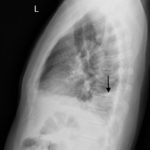Hampton’s Hump in Pulmonary Embolism
HPI:
A 51-year old male presented to the emergency department with right chest and flank pain, with intermittent cough productive of blood-tinged sputum. The patient denied shortness of breath. The patient was afebrile, had a heart rate of 104/min, respiratory rate of 18/min, and oxygen saturation of 98% on room air. Cardiopulmonary exam was unremarkable. Chest radiograph (shown) was concerning for Hampton’s hump. Subsequently, the diagnosis of pulmonary embolism was confirmed on CT angiography of the chest (shown).
Significant Findings:
In the lateral view chest x-ray, there is a Hampton’s Hump, a pleural based, wedge-shaped opacity at the base of the right lung, representing lung infarction (black arrow). These findings correlate with the sagittal view on CT angiography of the chest. The CT chest also shows a filling defect in the distal posterior basal segmental pulmonary artery (white arrow), as demonstrated by the absence of contrast enhancement in the distal portion of the vessel. This is associated with an opacification of the lung parenchyma distal to the occlusion (red arrow), representing lung infarction.
Discussion:
The diagnosis of pulmonary embolism is typically made by CT pulmonary angiography, but other diagnostic modalities include: ventilation-perfusion scan, d-dimer, ultrasound of the lower extremities, echocardiogram, electrocardiogram, chest radiograph, and clinical decision rules. Hampton’s hump (figure 1), a wedge-shaped consolidation with the base of the triangle against the pleura, was first described on the chest x-ray in the 1940s and is one finding that may be present on chest radiography.1-3
The presence of Hampton’s hump possesses a high specificity (82%), but has a low sensitivity (22%) for the diagnosis of pulmonary embolism.3,4 In patients with Hampton’s hump, CTA will confirm the diagnosis, showing a three-dimensional infarction distal to the embolus.
Topics:
Pulmonary embolism (PE), chest x-ray (CXR), CT angiography, respiratory, pulmonary, lung, emergency medicine, Hampton’s hump, pulmonary infarction.
References:
- Hampton AO, Castleman B. Correlation of postmortem chest teleroentgenograms with autopsy findings with special reference to pulmonary embolism and infarction. AJR Am J Roentgenol. 1940;43:305-326.
- Marshall GB, Farnquist BA, MacGregor JH, Burrowes PW. Signs in thoracic imaging. J Thorac Imaging. 2006;21(1):76-90. doi: 10.1097/01.rti.0000189192.70442.7a
- Worsley DF, Alavi A, Aronchick JM, Chen JT, Greenspan RH, Ravin CE. Chest radiographic findings in patients with acute pulmonary embolism: observations from the PIOPED Study. Radiology. 1993;189(1):133–136. doi: 10.1148/radiology.189.1.8372182
- Daehee H, Kyung SL, Tomas F, et al. Thrombotic and nonthrombotic pulmonary arterial embolism: spectrum of imaging findings. RadioGraphics. 2003;23(6):1521-1539. doi: 10.1148/rg.1103035043




